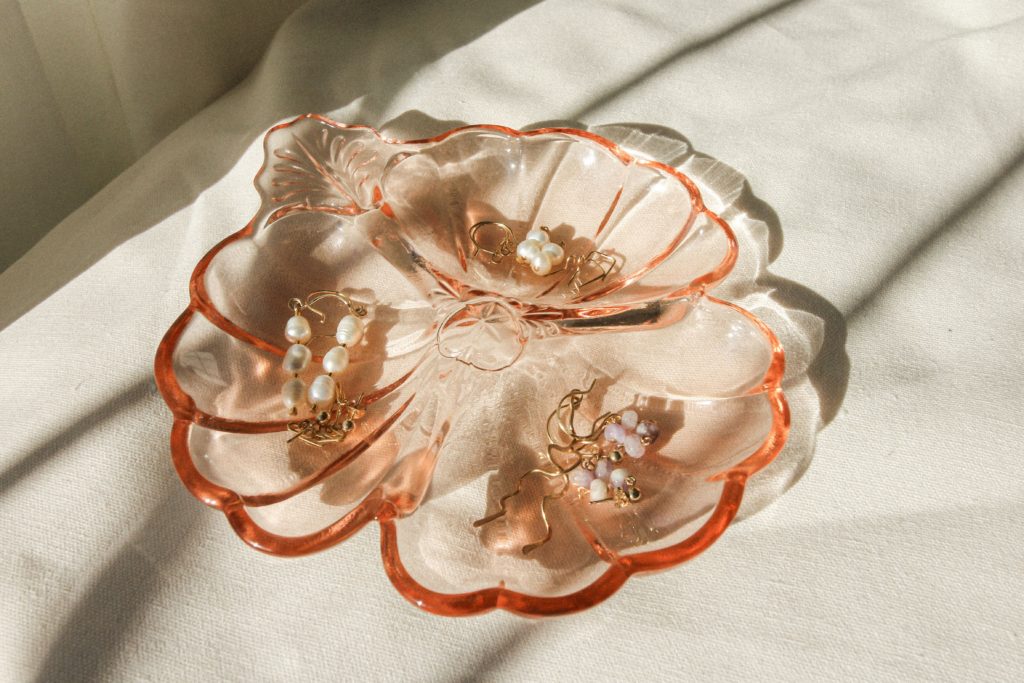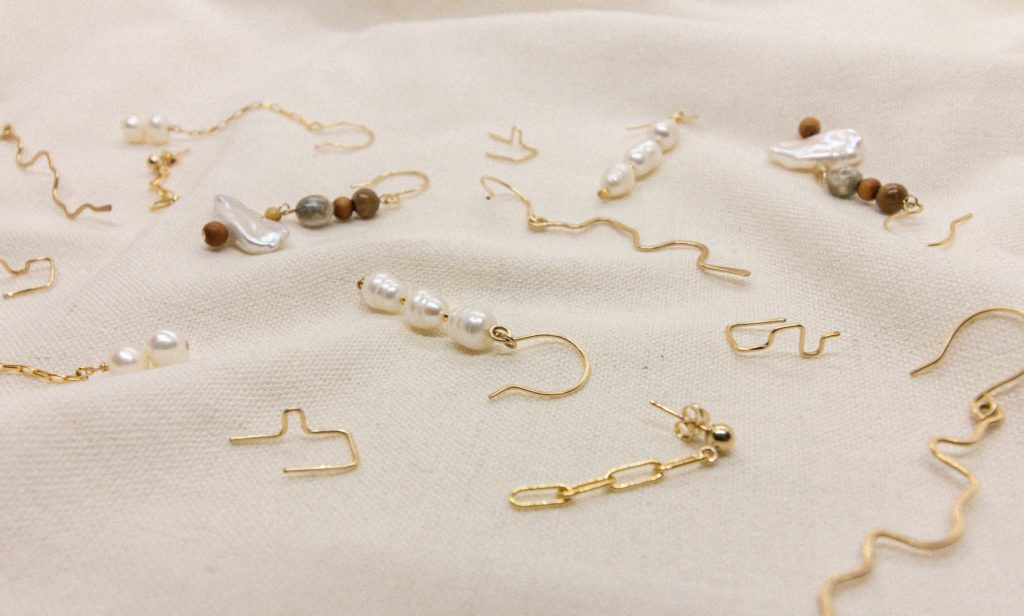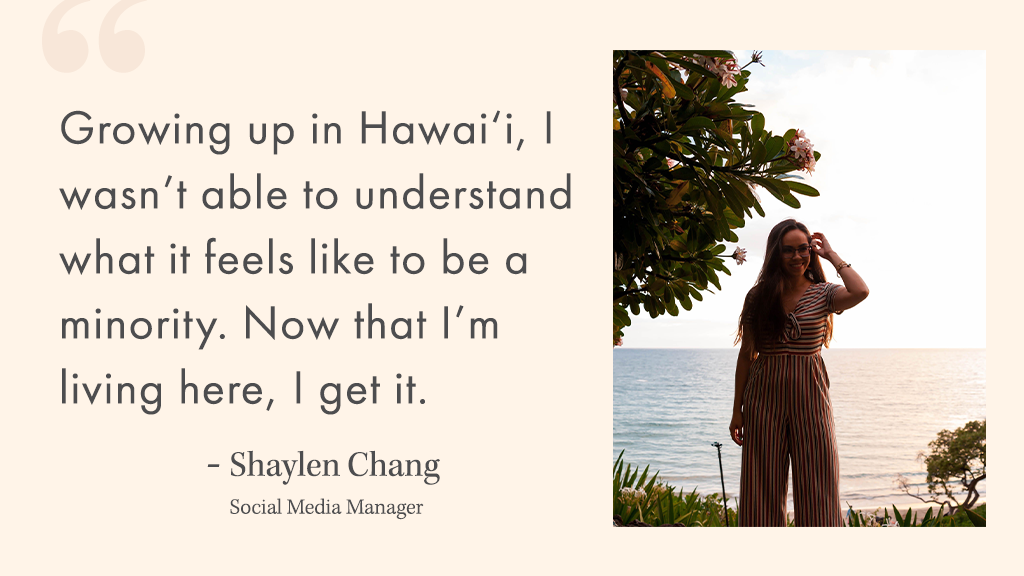Asian American and Pacific Islander Heritage Month
AAPI Voices: Meet Shaylen
May is Asian American and Pacific Islander Heritage (AAPI) Month, and we’re so excited to be celebrating it all month long. Throughout May, watch the B3 Magazine and barre3 Instagram for stories highlighting members of our global barre3 community who identify as AAPI.
Today, we’re featuring Shaylen Chang, the Social Media Manager at barre3. Read on to learn about how Shaylen never thought of herself as Asian-American until she moved from her home state of Hawai’i to the mainland, how her art addresses misconceptions about Hawaiian culture, and the food that she misses most from home.
BARRE3 MAGAZINE: Let’s start with your role at barre3! You’ve been working as the Social Media Manager for almost a year now. Can you tell us a little bit about what you do?
SHAYLEN: It’s been a fun year! I manage the barre3 organic social media channels including Instagram, Facebook, Twitter, TikTok, LinkedIn, Pinterest, and YouTube. My role entails strategizing and managing the daily content that’s published on these channels as well as collaborating with our team to create new content. Social media is always evolving, and how users interact with brands is always changing. Part of what I do is continuously try to understand the role social media plays in the barre3 community and help to engage with and support them on social media.
BARRE3 MAGAZINE: Your role gives you direct access to our global barre3 community. What have you learned about them over the past year?
SHAYLEN: The barre3 community is like none other. Seeing the community engage with each other every day whether they’re studio members, online subscribers, instructors, or all of the above is one of my favorite things about my role. It’s amazing to see a community that is so connected, inclusive, and supportive. Social media can be an incubator of toxicity, but watching from the front row, the barre3 community is a safe space where differences are welcomed and everyone is celebrated. I also love seeing the creative Instagram Reels that both studios and clients create that embody the barre3 spirit and messaging.
BARRE3 MAGAZINE: Your creativity extends far beyond your work at barre3. How did you first become interested in art, and how have you pursued it throughout your life?
SHAYLEN: I’ve always loved art growing up, whether it was through photography, jewelry, or hula. It was my way of storytelling and communicating my ideas. I studied Digital Art in college, where I fell in love with Conceptual Art and interactive installations. For my Master’s program in Communication, I researched how street art impacts the community for my thesis. Whatever the medium is, I love how accessible art can be as a catalyst for change and a vehicle for self-expression. I think it’s really important for community building and our individual mental health to be able to externalize our thoughts, beliefs, and passions in a way that is relatable and makes us feel comfortable sharing.
BARRE3 MAGAZINE: I love that perspective. Another way your channel your artistic energy is by making jewelry. How did you get started with it, and what’s your inspiration?
SHAYLEN: I’ve been making jewelry since I was 14 years old. I’ve always had really sensitive ears, and the moment I was able to wear earrings, I learned to make them myself. I taught myself through every magazine, book, video, and website I could find and would make my friends these really funky earrings that definitely looked like a teenager learning the medium.
In 2011, I started my first line of jewelry. However, throughout the years I was never fully confident or comfortable with the quality and designs of my jewelry. I always felt like I could do better or should make pieces that were more trendy. Last year, I finally launched Clemaeve (pronounced kleh-MAYV) and reached a place of love for the process and all of the pieces I make. It’s something that barre3 has taught me—it’s not about comparing my work to other brands or striving for perfection. Rather, I’m focusing on what feels authentically me in this moment and allowing the brand and myself to grow.
BARRE3 MAGAZINE: You grew up in Hawai‘i, where there’s a large AAPI community—the author Hanya Yanagihara, who lived there as a child, has referred to it as “the imaginary homeland” for Asian Americans. Can you talk a bit about your experience growing up there as someone who identifies as Asian American?
SHAYLEN: Growing up, I wasn’t familiar with the terms “Asian American” or “AAPI.” It wasn’t until recently that I started to understand what it means. Hawai‘i really is a melting pot, and diversity is a part of everyday life. I realize now that I was very privileged to feel a sense of belonging in that diversity. It’s only in Hawai‘i or with others from Hawai‘i that I don’t feel like an outsider.
BARRE3 MAGAZINE: Now you live in Portland, where the AAPI community isn’t nearly as big as it is in Hawai‘i. I’m curious about how your experience has been since moving here. Have you noticed big differences?
SHAYLEN: It’s been a challenge for me. Even though I spent four years in Eugene, Oregon for college, I didn’t realize how much I’d experience a culture shock living and working in Portland. On one hand, there are many differences in language, lifestyle, and social norms that come from the unique culture of Hawai‘i. On the other hand, it’s a big change in the visual landscape of people. When I was younger, I’d hear Asian American actresses and models talk about how they never saw anyone that looked like them, particularly in the media. Growing up in Hawai‘i, I wasn’t able to understand what it feels like to be a minority. Now that I’m living here, I get it. Many places I go to, I don’t feel like I belong—either I look too Asian or not Asian enough.
BARRE3 MAGAZINE: I know that for many people from Hawai‘i, food is a big part of the culture. What food do you miss the most?
SHAYLEN: The food is what I miss most! Luckily, I’ve been able to make a lot of the Asian and Hawaiian dishes that have been a normal part of dinner time growing up. But, there’s nothing like fresh ahi (tuna) poke and fresh poi (pounded taro mixed with water) from Hawai‘i.
BARRE3 MAGAZINE: Even though Hawai‘i is, obviously, part of the United States, people from the mainland sometimes have a lot of misconceptions about what life there is like. What’s something about Hawai‘i—and people from Hawai‘i—that you wish people understood better?
SHAYLEN: There’s much that can be said here. Hawai‘i is breathtakingly beautiful and the culture is incredibly rich, but there are many things that aren’t portrayed accurately or fully in the media. It’s a sensitive topic, and I can’t speak for everyone. Based on my own experiences, I’ve focused a lot of my artwork on the appropriation of Hawai‘i culture.
One of the concepts I’ve explored is the appropriation of hula adornments as party costumes. I’ve danced hula since I was 7 years old with traditional halau (hula school), and it’s something that’s widely mistranslated in popular culture from movies to themed parties. As a project, I took online images of “hula costumes” and separated the costumes from the models. I presented the separated images as a side-by-side comparison. What’s left is a dissected illustration leading the viewer to face the realities of the separate entities—are these authentic hula adornments? Are these individuals local to Hawai‘i? Are their poses authentic to traditional hula movements? I think questioning authenticity is something to be mindful and respectful of whenever referencing any culture.
Thank you, Shaylen!
May is Asian American and Pacific Islander Heritage (AAPI) Month, and we’re so excited to be celebrating it all month long. Throughout May, watch the B3 Magazine and barre3 Instagram for stories highlighting members of our global barre3 community who identify as AAPI.
Today, we’re featuring Shaylen Chang, the Social Media Manager at barre3. Read on to learn about how Shaylen never thought of herself as Asian-American until she moved from her home state of Hawai’i to the mainland, how her art addresses misconceptions about Hawaiian culture, and the food that she misses most from home.
BARRE3 MAGAZINE: Let’s start with your role at barre3! You’ve been working as the Social Media Manager for almost a year now. Can you tell us a little bit about what you do?
SHAYLEN: It’s been a fun year! I manage the barre3 organic social media channels including Instagram, Facebook, Twitter, TikTok, LinkedIn, Pinterest, and YouTube. My role entails strategizing and managing the daily content that’s published on these channels as well as collaborating with our team to create new content. Social media is always evolving, and how users interact with brands is always changing. Part of what I do is continuously try to understand the role social media plays in the barre3 community and help to engage with and support them on social media.
BARRE3 MAGAZINE: Your role gives you direct access to our global barre3 community. What have you learned about them over the past year?
SHAYLEN: The barre3 community is like none other. Seeing the community engage with each other every day whether they’re studio members, online subscribers, instructors, or all of the above is one of my favorite things about my role. It’s amazing to see a community that is so connected, inclusive, and supportive. Social media can be an incubator of toxicity, but watching from the front row, the barre3 community is a safe space where differences are welcomed and everyone is celebrated. I also love seeing the creative Instagram Reels that both studios and clients create that embody the barre3 spirit and messaging.
BARRE3 MAGAZINE: Your creativity extends far beyond your work at barre3. How did you first become interested in art, and how have you pursued it throughout your life?
SHAYLEN: I’ve always loved art growing up, whether it was through photography, jewelry, or hula. It was my way of storytelling and communicating my ideas. I studied Digital Art in college, where I fell in love with Conceptual Art and interactive installations. For my Master’s program in Communication, I researched how street art impacts the community for my thesis. Whatever the medium is, I love how accessible art can be as a catalyst for change and a vehicle for self-expression. I think it’s really important for community building and our individual mental health to be able to externalize our thoughts, beliefs, and passions in a way that is relatable and makes us feel comfortable sharing.
BARRE3 MAGAZINE: I love that perspective. Another way your channel your artistic energy is by making jewelry. How did you get started with it, and what’s your inspiration?
SHAYLEN: I’ve been making jewelry since I was 14 years old. I’ve always had really sensitive ears, and the moment I was able to wear earrings, I learned to make them myself. I taught myself through every magazine, book, video, and website I could find and would make my friends these really funky earrings that definitely looked like a teenager learning the medium.
In 2011, I started my first line of jewelry. However, throughout the years I was never fully confident or comfortable with the quality and designs of my jewelry. I always felt like I could do better or should make pieces that were more trendy. Last year, I finally launched Clemaeve (pronounced kleh-MAYV) and reached a place of love for the process and all of the pieces I make. It’s something that barre3 has taught me—it’s not about comparing my work to other brands or striving for perfection. Rather, I’m focusing on what feels authentically me in this moment and allowing the brand and myself to grow.
BARRE3 MAGAZINE: You grew up in Hawai‘i, where there’s a large AAPI community—the author Hanya Yanagihara, who lived there as a child, has referred to it as “the imaginary homeland” for Asian Americans. Can you talk a bit about your experience growing up there as someone who identifies as Asian American?
SHAYLEN: Growing up, I wasn’t familiar with the terms “Asian American” or “AAPI.” It wasn’t until recently that I started to understand what it means. Hawai‘i really is a melting pot, and diversity is a part of everyday life. I realize now that I was very privileged to feel a sense of belonging in that diversity. It’s only in Hawai‘i or with others from Hawai‘i that I don’t feel like an outsider.
BARRE3 MAGAZINE: Now you live in Portland, where the AAPI community isn’t nearly as big as it is in Hawai‘i. I’m curious about how your experience has been since moving here. Have you noticed big differences?
SHAYLEN: It’s been a challenge for me. Even though I spent four years in Eugene, Oregon for college, I didn’t realize how much I’d experience a culture shock living and working in Portland. On one hand, there are many differences in language, lifestyle, and social norms that come from the unique culture of Hawai‘i. On the other hand, it’s a big change in the visual landscape of people. When I was younger, I’d hear Asian American actresses and models talk about how they never saw anyone that looked like them, particularly in the media. Growing up in Hawai‘i, I wasn’t able to understand what it feels like to be a minority. Now that I’m living here, I get it. Many places I go to, I don’t feel like I belong—either I look too Asian or not Asian enough.
BARRE3 MAGAZINE: I know that for many people from Hawai‘i, food is a big part of the culture. What food do you miss the most?
SHAYLEN: The food is what I miss most! Luckily, I’ve been able to make a lot of the Asian and Hawaiian dishes that have been a normal part of dinner time growing up. But, there’s nothing like fresh ahi (tuna) poke and fresh poi (pounded taro mixed with water) from Hawai‘i.
BARRE3 MAGAZINE: Even though Hawai‘i is, obviously, part of the United States, people from the mainland sometimes have a lot of misconceptions about what life there is like. What’s something about Hawai‘i—and people from Hawai‘i—that you wish people understood better?
SHAYLEN: There’s much that can be said here. Hawai‘i is breathtakingly beautiful and the culture is incredibly rich, but there are many things that aren’t portrayed accurately or fully in the media. It’s a sensitive topic, and I can’t speak for everyone. Based on my own experiences, I’ve focused a lot of my artwork on the appropriation of Hawai‘i culture.
One of the concepts I’ve explored is the appropriation of hula adornments as party costumes. I’ve danced hula since I was 7 years old with traditional halau (hula school), and it’s something that’s widely mistranslated in popular culture from movies to themed parties. As a project, I took online images of “hula costumes” and separated the costumes from the models. I presented the separated images as a side-by-side comparison. What’s left is a dissected illustration leading the viewer to face the realities of the separate entities—are these authentic hula adornments? Are these individuals local to Hawai‘i? Are their poses authentic to traditional hula movements? I think questioning authenticity is something to be mindful and respectful of whenever referencing any culture.
Thank you, Shaylen!












0 people have left a comment. Join the conversation!
View Comments